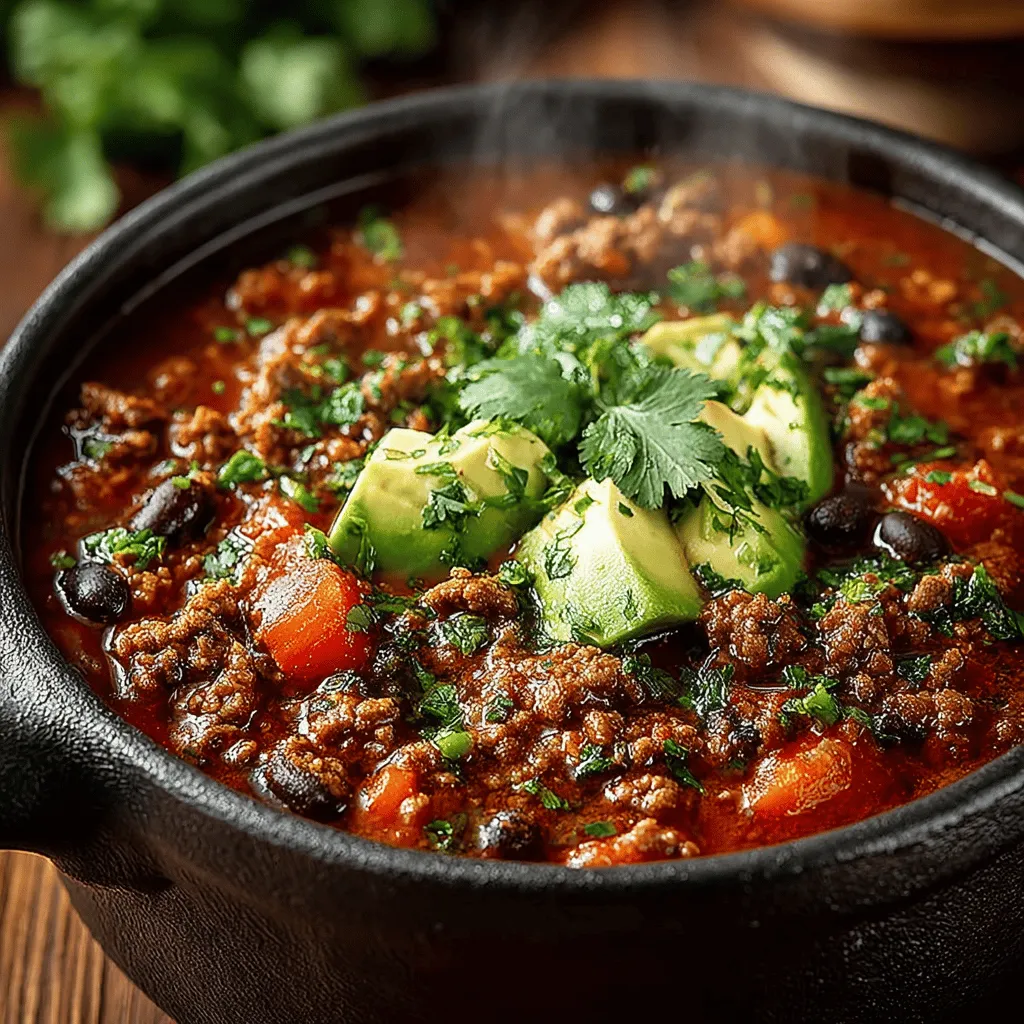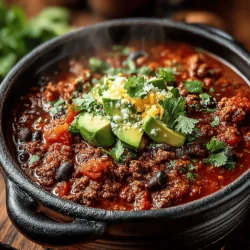Spicy Quick Beef and Bean Chili Recipe
Chili is a dish that has earned its place in the hearts of many as a quintessential comfort food. Its origins can be traced back to the American Southwest, where it was crafted from simple ingredients yet packed with rich flavors. Over the years, chili has evolved into a beloved staple, with countless variations that reflect regional preferences and personal tastes. Whether served on game day, at a family gathering, or as a cozy weeknight dinner, chili consistently warms both the body and soul.
In today’s fast-paced world, the need for quick and easy recipes has never been more pronounced. Home cooks are constantly seeking ways to whip up satisfying meals without sacrificing flavor or quality. Enter the Spicy Quick Beef and Bean Chili—a recipe designed for those who crave a hearty, spicy dish that can be prepared in a fraction of the time traditionally required for chili. This dish combines the robust flavors of ground beef and an assortment of beans, with a spicy kick that will excite your taste buds.
Understanding the Flavor Profile of Chili
The magic of chili lies in its complex flavor profile, which is largely shaped by the spices and ingredients used. Spices play a crucial role in elevating the taste, creating a harmonious blend that can be customized according to your preferences. In our Spicy Quick Beef and Bean Chili, we utilize an array of spices that not only contribute heat but also enhance the overall depth of flavor. It’s essential to balance the heat with other elements—sweetness from tomatoes, savory notes from beef, and umami from beans—to craft a chili that is both satisfying and nuanced.
Chili is also a dish that lends itself to cultural variation. From the classic American chili con carne to the spicy variations found in Mexican and Southwestern cuisines, each recipe tells a story. This versatility allows for creativity, encouraging home cooks to experiment and make the dish their own.
Ingredient Breakdown
To create a truly delicious Spicy Quick Beef and Bean Chili, it’s important to select quality ingredients that will contribute to the dish’s overall flavor and texture. Here’s a closer look at the key components:
– Ground Beef: The star of this recipe, ground beef serves as the primary source of protein and flavor. When cooked to perfection, it provides a rich, savory base that complements the other ingredients beautifully.
– Black Beans and Kidney Beans: These legumes not only add nutritional benefits, such as fiber and protein, but they also bring a delightful texture to the chili. Their creamy consistency contrasts nicely with the robust meat and adds a heartiness that makes this dish especially filling.
– Diced Tomatoes with Green Chilies: This ingredient introduces acidity and a touch of heat to the chili. The tomatoes provide a rich base, while the green chilies infuse an extra layer of flavor that enhances the overall spiciness.
– Spices: A blend of chili powder, cumin, smoked paprika, and cayenne pepper is essential for achieving the bold flavor that chili lovers crave. Each spice contributes its unique profile: chili powder adds warmth, cumin brings an earthy tone, smoked paprika provides depth, and cayenne pepper delivers a fiery kick.
– Fresh Produce: Onions and garlic serve as aromatic foundations, enhancing the richness of the dish. Topping the chili with fresh avocado and cilantro not only adds a burst of color but also a refreshing contrast to the spiciness.
Preparation Steps Explained
Now that you’re familiar with the ingredients, let’s dive into the preparation steps that will set you on the path to chili perfection:
1. Heating the Olive Oil: Begin by heating a generous drizzle of olive oil in a large pot or Dutch oven over medium heat. The importance of reaching the right temperature cannot be overstated; too cool, and the meat will steam instead of brown, while too hot may cause the oil to smoke. A properly heated pan is crucial for achieving that coveted caramelization on the ground beef, which will enhance the overall flavor of the chili.
2. Cooking Ground Beef: Once the oil is shimmering, add the ground beef to the pot. Use a wooden spoon or spatula to break it apart, spreading it evenly across the surface. Allow it to cook without stirring for a few minutes to develop a nice brown crust on one side. This browning process adds depth and richness to the dish. After a few minutes, stir the beef, breaking it up further, and continue cooking until it is fully browned and no longer pink. This step is vital; undercooked beef can detract from the dish’s safety and flavor.
As we move forward, we’ll continue to build on this hearty foundation, adding the remaining ingredients that will transform our dish into a spicy masterpiece. Stay tuned for the next steps in creating your Spicy Quick Beef and Bean Chili, where we will layer in the flavors that make this recipe a standout.

Adding Garlic and Spices: Timing for Optimal Flavor Release
To elevate your Spicy Quick Beef and Bean Chili, the timing of adding garlic and spices is crucial. Begin by sautéing your onions and bell peppers until they soften. This initial step creates a flavor base. After about 5 minutes, it’s time to introduce the minced garlic. Garlic can become bitter if cooked for too long, so adding it just before your spices allows it to infuse the oil without losing its fresh flavor.
Once the garlic becomes fragrant—approximately 30 seconds to a minute—you can add your spices. This includes chili powder, cumin, smoked paprika, and any additional spices you prefer. Toasting the spices briefly in the hot oil enhances their aroma and flavor, making them more pronounced in your chili. Stir them into the mixture and let them cook for another minute before proceeding to the next steps.
Combining Ingredients: Best Practices for Layering Flavors
When it comes to making a chili that sings with flavor, the order in which you combine your ingredients matters. After the spices have been toasted, add your browned ground beef back into the pot. This allows the beef to absorb the freshly toasted spices, integrating those flavors into the meat.
Next, incorporate the canned tomatoes and beans—drain the beans first, but don’t rinse them to retain some of their starch, which can help thicken the chili. Stir gently to combine all ingredients evenly. If you’re using any fresh herbs, such as cilantro or oregano, now is the time to add them, as their oils will meld beautifully with the other ingredients.
After everything is combined, pour in the broth or water. The liquid should cover your mixture but not drown it; you want a thick, hearty chili. This layering of flavors—starting with the aromatics and spices and building up with the meat, beans, and tomatoes—creates a complex and satisfying dish.
Simmering the Chili: How Long to Simmer for the Best Results
The simmering phase is where all the flavors meld together, creating a rich and comforting chili. Ideally, let your chili simmer for at least 20 to 30 minutes. This timeframe allows the beef to become tender and the spices to fully develop their flavors. However, if you have the time, simmering for up to an hour will yield even better results.
During this simmering phase, taste your chili periodically. Adjust the seasoning as needed, adding salt, pepper, or a dash of hot sauce if you prefer more heat. If your chili appears too thick, you can always add a splash more broth or water. Conversely, if it’s too thin, let it simmer uncovered to allow some of the excess liquid to evaporate.
Nutritional Benefits of Spicy Quick Beef and Bean Chili
Caloric Information and Macronutrient Breakdown
One of the appealing aspects of this Spicy Quick Beef and Bean Chili recipe is its balance of macronutrients. A typical serving (about 1 cup) contains approximately 350-400 calories, depending on the specific ingredients used. This serving typically includes around 25 grams of protein, 20 grams of carbohydrates, and approximately 15 grams of fat. This makes it a well-rounded meal that satisfies hunger while providing essential nutrients.
Health Benefits of Beans: Fiber and Protein Content
Beans are a powerhouse ingredient in this chili, providing not only protein but also a significant amount of dietary fiber. Each serving of chili can contain 8-10 grams of fiber, which is beneficial for digestive health and can help maintain stable blood sugar levels. Additionally, the protein found in beans contributes to muscle repair and growth, making this dish a great choice for active individuals.
The Role of Spices in Metabolism and Overall Health
The spices in your chili also pack a health punch. Ingredients like chili powder and cumin not only enhance flavor but can also boost metabolism. Capsaicin, the compound that gives chili peppers their heat, has been shown to increase metabolic rate and promote fat burning. Moreover, spices like garlic have antioxidant properties, contributing to overall health.
Customizing the Recipe for Dietary Preferences
For those with dietary restrictions or preferences, this chili recipe is easily customizable. You can substitute ground beef with ground turkey or chicken for a leaner option. Alternatively, for a vegetarian or vegan version, consider using plant-based meat alternatives or simply increasing the quantity of beans and adding vegetables such as zucchini or corn. This versatility allows everyone to enjoy a delicious bowl of chili.
Serving Suggestions
Ideal Pairings: What to Serve with Chili for a Complete Meal
Chili is a hearty dish that can stand on its own, but it also pairs well with a variety of sides. For a complete meal, consider serving it with cornbread or a side of rice to soak up those delicious flavors. A simple green salad can add a refreshing contrast and balance the richness of the chili.
Creative Toppings: Beyond Avocado and Cilantro, Exploring Other Garnishes
When it comes to toppings, there are countless options to elevate your chili experience. While avocado and cilantro are popular choices, consider adding shredded cheese for creaminess, sour cream for a tangy finish, or sliced jalapeños for extra heat. Crushed tortilla chips or Fritos can provide a delightful crunch, while lime wedges add a zesty kick that brightens the dish.
Presentation Ideas: Making Chili Visually Appealing
Presentation can enhance the dining experience. Serve your chili in rustic bowls with a sprinkle of fresh herbs on top for a pop of color. Adding a dollop of sour cream or Greek yogurt in the center creates an appealing contrast. Accompanying it with colorful toppings on the side allows guests to customize their bowls while adding visual interest to the table.
Cultural Significance of Chili
The History of Chili in American Cuisine
Chili has deep roots in American culinary history, particularly in the southwestern United States. It is believed to have originated from a combination of Spanish, Native American, and Mexican cuisines. The first chili recipes date back to the 1800s, when settlers sought to create a hearty dish that could be made with preserved ingredients, such as dried beans and meat.
Regional Variations and Adaptations of Chili Recipes
Throughout the years, chili has evolved, leading to various regional adaptations. Texas chili, often made without beans, focuses on the meat and spices. Meanwhile, Cincinnati chili is known for its unique blend of spices and is typically served over spaghetti. Each variation reflects the cultural influences and local ingredients, showcasing the versatility of this beloved dish.
Chili as a Communal Dish: Importance in Gatherings and Celebrations
Chili is more than just a meal; it is a communal dish that brings people together. Often served at gatherings, potlucks, and tailgates, chili fosters a sense of community. The act of sharing a pot of chili encourages conversation and connection, making it a perfect dish for celebrations and family gatherings.
Conclusion
Making Spicy Quick Beef and Bean Chili is not only a rewarding culinary experience but also a great way to nourish yourself and your loved ones. With its rich flavors, nutritional benefits, and versatility, this recipe is sure to become a favorite in your household.
We encourage you to try this recipe at home, experiment with your variation, and share it with family and friends. Cooking is not just about creating a meal; it is about the joy of sharing good food and creating lasting memories with those you care about. Embrace the process, savor the flavors, and enjoy the warmth of your delicious chili.


